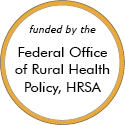Kentucky Models and Innovations
These stories feature model programs and successful rural projects that can serve as a source of ideas. Some of the projects or programs may no longer be active. Read about the criteria and evidence-base for programs included.
Effective Examples
Farm Dinner Theater
Updated/reviewed November 2025
- Need: To encourage farmers to make health and safety changes on their farms.
- Intervention: Farm Dinner Theater is an event in which farmers and their families watch three 10-minute plays covering health and safety topics and then discuss solutions to the issues addressed in each.
- Results: In a study, farmers who attended the plays were more likely to make changes and tell others what they learned, compared to farmers who received an educational packet with the same information.
Kentucky Homeplace
Updated/reviewed October 2025
- Need: Rural Appalachian Kentucky residents have deficits in health resources and health status, including high levels of cancer, heart disease, hypertension, asthma, and diabetes.
- Intervention: Kentucky Homeplace was created as a community health worker initiative to provide health coaching, increased access to health screenings, and other services.
- Results: From July 2001 to June 2025, over 202,000 rural residents were served. Preventive health strategies, screenings, educational services, and referrals are all offered at no charge to clients.
Community Health Worker-based Chronic Care Management Program
Updated/reviewed August 2024
- Need: Improve healthcare access and decrease chronic disease disparities in rural Appalachia.
- Intervention: A unique community health worker-based chronic care management program, created with philanthropy support.
- Results: After a decade of use in attending to population health needs, health outcomes, healthcare costs, in 2024, the medical condition-agnostic model has a 4-year track record of financial sustainability with recent scaling to include 31 rural counties in a 3-state area of Appalachia and recent implementation in urban areas.
Promising Examples
Successfully Training and Educating Pre-medical Students (STEPS)
Updated/reviewed March 2025
- Need: To increase the number of primary care providers in northeast Kentucky.
- Intervention: STEPS provides support such as physician shadowing, mock interviews, and MCAT practice courses/exams for regional students applying to medical school.
- Results: Approximately 65% of participants have been accepted into medical school. The program has been replicated among most of Kentucky's regional AHECs.
Contingency Management Smoking Cessation in Appalachia
Updated/reviewed June 2022
- Need: To reduce smoking rates of pregnant women and adolescents in Appalachian regions of eastern Kentucky and Ohio.
- Intervention: A web-based smoking cessation program that offered monetary incentives to reducing smoking.
- Results: Participants significantly reduced smoking rates or quit altogether.
Other Project Examples
The Sapling Center
Updated/reviewed June 2025
- Need: To create a safe space for youth and young adults, ages 14 to 25, in rural eastern Kentucky.
- Intervention: The Sapling Center provides independent living skills education and offers a wide array of services as well as fun activities in a supportive environment.
- Results: The 5 Sapling Center locations serve 50-75 teens and young adults every day.
Recovery Kentucky
Updated/reviewed April 2025
- Need: To provide housing and recovery services for rural Kentuckians dealing with substance use.
- Intervention: Recovery Kentucky has 8 rural locations and provides apartments within a congregate living environment and an opportunity to begin recovery from substance use disorder in a structured, peer-led 12-step environment.
- Results: The rural and urban centers serve up to 2,200 people annually. An independent university-led resident outcome evaluation showed significant improvements in clients' drug and alcohol use, housing and employment status, decrease in criminal justice improvement, and improved health and mental health.
Camp Mariposa
Updated/reviewed August 2024
- Need: To help children whose family members are struggling with substance misuse.
- Intervention: A year-round program provides mentoring as well as substance use prevention education.
- Results: In 2023, Camp Mariposa served a total of 113 youth in its four rural locations in Indiana, Kentucky, Tennessee, and West Virginia. In a study, 92% of participants reported no use of any substance to get high.
First Day Forward

Added March 2024
- Need: Enhanced support for people with substance use disorders leaving jail and reentering communities in rural northeastern Kentucky.
- Intervention: A reentry program that uses peer support specialists to teach cognitive life skills, obtain essential identification documents, and help people create and follow personalized case plans before and after their release.
- Results: More than 420 people have been served by First Day Forward, with recidivism rates significantly lower among people who successfully completed the program.
Last Reviewed: 9/15/2025

